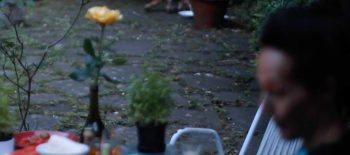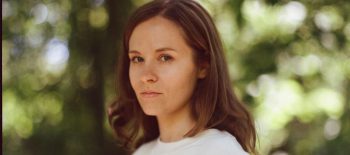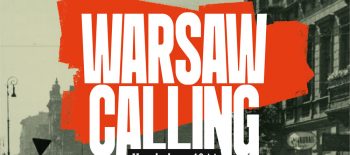From 12th December the poignant exhibition “I open my eyes, there’s no one” will be on display at Cruickshank Botanic Garden in Aberdeen. This is a result of collaboration between the University of Aberdeen and the Polish Association Aberdeen, a Polish diaspora organization established in 1993, whose ambition is to create and strengthen a positive image of Poland and Poles, promote democracy, human rights, including the rights of ethnic minorities.
By referring to universal values, the exhibition deals with a difficult but important subject in an original and accessible way. It tells the story of the copyists from the Białystok ghetto, Jewish artists whose talent was exploited by the Nazis, which, however, did not protect them from extermination. The unique narrative of the exhibition is taken over by memoirs and graphics of Izaak Celnikier, a Holocaust survivor, a Jewish painter born in Poland, a prisoner of the ghetto and concentration camps, a participant of death marches, whose story was a direct pretext for the exhibition.
Thanks to Celnikier’s unpublished manuscripts and his post-war works, which were made available by the artist’s family for the project, it will be possible to experience the events of the Białystok ghetto through the artist’s words and art, gaining the true perspective of a participant in the events.
Marta Surowiec, curator of the exhibition said: “We wanted the exhibition to be dominated by art and its “universal” language appealing to emotions – hence the manuscripts and the series of graphic works by Izaak Celnikier presenting the events in the ghetto in the timeline. Moreover, QR codes placed next to artists’ biographies redirect the viewer to a website dedicated to the exhibition, where their works will be available.”
The main theme of Celnikier’s artworks is the cruelty of the Second World War as well as the martyrdom and extermination of European Jews. His unique style refers to Francisco Goya’s art, giving testimony to crime and genocide in an equally expressive and suggestive manner.
The exhibition will present the artist’s works from the collection called La mémoire gravée, “Engraved in memory“. Many of the presented artworks relate directly to the events in the Białystok ghetto.
About Izaak Celnikier
Izaak Celnikier was born in Warsaw in a poor Jewish family. When the war started, he was 16 years old. He reached Białystok with his mother and sister in 1939, escaping the German occupation. In the first years of the war, in the city occupied by the USSR, Izaak started to learn drawing under the supervision of experienced Jewish artists who, like him and his family, came to Białystok in fear of their own lives. Among them were Gina and Abraham Frydman, Stanisława Cetnerszwerowa, Natalia Landau, Chaim Uryson, Chaim Tyber and the Seidenbeutel brothers. Later, the artists copied works of art in an atelier located in the ghetto.
After the Germans entered Białystok in 1941, Izaak, together with his mother and sister, ended up in the ghetto, where he managed to find employment in the studio of a German officer and industrialist, Oskar Steffen.
In September 1941, Oskar Steffen, a German officer and industrialist, recognized the potential of Jewish numerous artists in the ghetto and set up an artistic copy workshop. Steffen equipped the workshop with easels and the necessary facilities for effective work and supplied the highest quality paints and painting materials. Working on a piecework basis, the artists, at the owner’s behest, made wholesale copies of paintings by great masters of European painting, including Murillo, Titian, Rubens and 19th-century German classics, most probably Caspar David Friedrich and Arnold Böcklin.
No extra pay or increased rations were received in return for the work as the owner of the studio did not perceive them as artists, but as a “cheap labour force”, recognizing that the work was not exhausting. The copies were transported two or three times a week by truck to the palace in Dojlidy, the residence of Erich Koch, head of the Bialystok District Civil Administration, and then deep into Germany. The history of the workshop is known only from the testimony of Izaak Celnikier given after the war. At that time Celnikier did not paint but was helpful by stretching and priming canvases and taking care of the supply of paints and tools for the artists working in the studio.
The studio was led by Abraham Behrmann, who was responsible for the organization and efficiency of work. The names of the other artists employed in the atelier are uncertain. Most likely they were: Chaim Tyber, Tobiasz Haber, Chaim Uryson, Fania Helman, Gina Frydman, Natalia Landau, Oskar Rozaniecki, Bernard Rolnicki, Bencjon Rolnicki, Stanisława Centnerszwerowa, Meir Berman, Nachum Edelman, Hanna Rozenman, Estera Amalia Bernzweig. Efraim and Menashe Seidenbeutel probably also worked there.
Of the nearly twenty members of the atelier, only Celnikier managed to get through the war, as he repeatedly emphasizes, that he was destined to survive to bear witness to the life and death of his family, friends, and other Jews.
Isaac wrote in his memoirs: “Here is art and life. Art and death. I open my eyes, there’s no one. I try to fall asleep again, and those who push me out come back in, the features are concrete, or almost, overlapping. Nothing. Spectres. Then there is no more sleep, no more daydreams, no more ghosts, just a vague memory of a reflection – say of this one or those they cut off their beards, laughing. (…) and here I find myself among my people, still alive. I forget all the pleasures of what is ‘beautiful and sublime’ around me, and I wonder if, in this case, it would not be a ‘lack of shame’, on the contrary, to turn away from one of the sources and keys of our memory” (Isaac Celnikier, My Reading of Rembrandt, unpublished typescript, from the archive of the artist’s family). The artist died in Paris in 2011.
About the exhibition
The knowledge about the artists from the Białystok Ghetto is very fragmentary, therefore the exhibition was preceded by months-long research through the collections of museums, archives and private collections in Poland, Germany, Israel, the United States and France. Many of the photographs and reproductions made available during the exhibition have not been published before.
The curator Marta Surowiec said: “Especially valuable is the collection of completely unknown works by Chaim Urson from the Art Department Museums Division in Yad Vashem. The search involved, among others: The Jewish Historical Institute, the National Museum in Warsaw, the Archives of the Academy of Fine Arts in Warsaw, the Historical Museum in Białystok, the Białystok Cultural Centre and the archives of the Bundesarchiv (German Federal Archives).”
Marta Surowiec is not only the curator but also the originator and author of the project. As a graduate of the Wrocław Academy of Fine Arts, she professionally deals with visual identification design, communication strategy and brand building. She is passionate about Warsaw’s modernist architecture and has won design awards, including the international European Design Awards (ED-Awards). She currently lives in Scotland where she is involved in activities for the Polish community and the popularisation of Polish history, culture and national heritage.
The co-authors of the exhibition are Ewa Rogalewska, who outlined the history of the Bialystok ghetto, Zuzanna Benesz-Goldfinger, who focused on the life and work of Izaak Celnikier, who also collaborated on the exhibition’s foundation, Joanna Tomalska-Więcek and Jolanta Szczygieł Rogowska, who told the story of the copyists’ workshop.
Surowiec said: “We wanted the communication of the exhibition to be multifaceted. Hence the idea of zones, making up a full picture of the history of the Białystok Ghetto copyists’ workshop and inviting to the project several authors, for whom each part of the exhibition is related to her passion or the subject of her work and research. Thanks to this, subsequent displays have an individual character. When designing the exhibition, I reinforced this assumption through the diverse form of the “stands” and a layout dedicated to each zone, different for each of them. What unifies the project is the iconography, which is overarching, maintained in a uniform aesthetic. This gives the exhibition a dynamic and expressive structure.”
The exhibition will be placed on free-standing displays and will create a kind of open museum, breaking the distance of traditional exhibitions.
Surowiec explained: “In the era of the pandemic and related restrictions, we wanted to reach the widest possible audience and create a space in which the viewer will unusually come into contact with history. We hope that this unusual form will completely change the viewer’s perception, and the use of the natural silence of the garden will create a background conducive to reflection.”
“In the face of the tragedy of the Holocaust, the questions of the essence of humanity and what defines its attitudes and boundaries become crucial. During the exhibition, we ask ourselves the question: how could degeneration on such a large scale occur in the centre of Europe, by a nation so distinguished for world culture, science, and art? What were the realities that shaped the circumstances in which people with the will, capital, and support to carry out the most horrific crime against humanity came to power?”
“That is why, 76 years after World War II, we are committed to bearing witness to the truth and opposing its detachment from historical reality. Only through education and awareness-building, we have a chance to create socially responsible attitudes. If we do not react in time to the loss of elementary human rights, at any moment we may wake up in a different reality.”
About “The History Zone”
The exhibition initiates the first of a series of projects that make up the “History Zone” program created by the Polish Aberdeen Association. The main objectives of the “History Zone” are to disseminate the cultural heritage of Poland, to create its image and international integration to build local patriotism.
Mateusz Łagoda, the chairman of the PAA said: “In each of the ongoing projects we focus on issues related to the history and culture of Scotland. In this way, we will gradually create a series referring to the historical legacy of both countries. Our ambition is to create a long-term project which, using modern language and communication channels, will promote the knowledge of Poland’s historical identity regarding its heritage and traditions.”
“We want our projects to be distinguished by their original character and individually designed, dynamic structure. We hope that through a modern form of communication and cultural animation as well as the open formula of the project we will be able to achieve multi-generational and multi-cultural integration. Simultaneously with the outdoor events, the website historyzone.uk will be created, which will allow us to increase the reach of the events”



